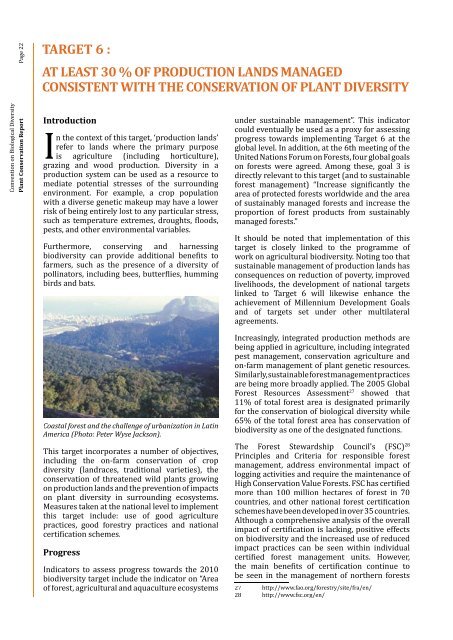from the global partnership for plant conservation
from the global partnership for plant conservation
from the global partnership for plant conservation
You also want an ePaper? Increase the reach of your titles
YUMPU automatically turns print PDFs into web optimized ePapers that Google loves.
Convention on Biological DiversityPlant Conservation Report Page 22TARGET 6 :AT LEAST 30 % OF PRODUCTION LANDS MANAGEDCONSISTENT WITH THE CONSERVATION OF PLANT DIVERSITYIntroductionIn <strong>the</strong> context of this target, ‘production lands’refer to lands where <strong>the</strong> primary purposeis agriculture (including horticulture),grazing and wood production. Diversity in aproduction system can be used as a resource tomediate potential stresses of <strong>the</strong> surroundingenvironment. For example, a crop populationwith a diverse genetic makeup may have a lowerrisk of being entirely lost to any particular stress,such as temperature extremes, droughts, loods,pests, and o<strong>the</strong>r environmental variables.Fur<strong>the</strong>rmore, conserving and harnessingbiodiversity can provide additional beneits tofarmers, such as <strong>the</strong> presence of a diversity ofpollinators, including bees, butterlies, hummingbirds and bats.under sustainable management”. This indicatorcould eventually be used as a proxy <strong>for</strong> assessingprogress towards implementing Target 6 at <strong>the</strong><strong>global</strong> level. In addition, at <strong>the</strong> 6th meeting of <strong>the</strong>United Nations Forum on Forests, four <strong>global</strong> goalson <strong>for</strong>ests were agreed. Among <strong>the</strong>se, goal 3 isdirectly relevant to this target (and to sustainable<strong>for</strong>est management) “Increase signiicantly <strong>the</strong>area of protected <strong>for</strong>ests worldwide and <strong>the</strong> areaof sustainably managed <strong>for</strong>ests and increase <strong>the</strong>proportion of <strong>for</strong>est products <strong>from</strong> sustainablymanaged <strong>for</strong>ests.”It should be noted that implementation of thistarget is closely linked to <strong>the</strong> programme ofwork on agricultural biodiversity. Noting too thatsustainable management of production lands hasconsequences on reduction of poverty, improvedlivelihoods, <strong>the</strong> development of national targetslinked to Target 6 will likewise enhance <strong>the</strong>achievement of Millennium Development Goalsand of targets set under o<strong>the</strong>r multilateralagreements.Coastal <strong>for</strong>est and <strong>the</strong> challenge of urbanization in LatinAmerica (Photo: Peter Wyse Jackson).This target incorporates a number of objectives,including <strong>the</strong> on-farm <strong>conservation</strong> of cropdiversity (landraces, traditional varieties), <strong>the</strong><strong>conservation</strong> of threatened wild <strong>plant</strong>s growingon production lands and <strong>the</strong> prevention of impactson <strong>plant</strong> diversity in surrounding ecosystems.Measures taken at <strong>the</strong> national level to implementthis target include: use of good agriculturepractices, good <strong>for</strong>estry practices and nationalcertiication schemes.ProgressIndicators to assess progress towards <strong>the</strong> 2010biodiversity target include <strong>the</strong> indicator on “Areaof <strong>for</strong>est, agricultural and aquaculture ecosystemsIncreasingly, integrated production methods arebeing applied in agriculture, including integratedpest management, <strong>conservation</strong> agriculture andon-farm management of <strong>plant</strong> genetic resources.Similarly, sustainable <strong>for</strong>est management practicesare being more broadly applied. The 2005 GlobalForest Resources Assessment 27 showed that11% of total <strong>for</strong>est area is designated primarily<strong>for</strong> <strong>the</strong> <strong>conservation</strong> of biological diversity while65% of <strong>the</strong> total <strong>for</strong>est area has <strong>conservation</strong> ofbiodiversity as one of <strong>the</strong> designated functions.The Forest Stewardship Council's (FSC) 28Principles and Criteria <strong>for</strong> responsible <strong>for</strong>estmanagement, address environmental impact oflogging activities and require <strong>the</strong> maintenance ofHigh Conservation Value Forests. FSC has certiiedmore than 100 million hectares of <strong>for</strong>est in 70countries, and o<strong>the</strong>r national <strong>for</strong>est certiicationschemes have been developed in over 35 countries.Although a comprehensive analysis of <strong>the</strong> overallimpact of certiication is lacking, positive effectson biodiversity and <strong>the</strong> increased use of reducedimpact practices can be seen within individualcertiied <strong>for</strong>est management units. However,<strong>the</strong> main beneits of certiication continue tobe seen in <strong>the</strong> management of nor<strong>the</strong>rn <strong>for</strong>ests27 http://www.fao.org/<strong>for</strong>estry/site/fra/en/28 http://www.fsc.org/en/
















